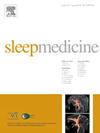Comparative efficacy of non-pharmacological interventions for adults with sleep apnea: A systematic review and network meta-analysis
IF 3.8
2区 医学
Q1 CLINICAL NEUROLOGY
引用次数: 0
Abstract
Background
Sleep apnea is associated with cardiovascular risk, work productivity, occupational/traffic accidents, and quality-of-life (QoL); however uncertainty exists regarding optimal treatment. We performed a systematic review on the efficacy of non-pharmacological interventions for adults with sleep apnea.
Method
We searched MEDLINE, Scopus, Virtual-Health-Library and Web-of-Science through June 2023 for parallel/cross-over randomized trials on adults with sleep apnea (apnea-hypopnea-index>5 events/hour). Study selection, data extraction and risk-of-bias assessment were performed in duplicate, followed by frequentist network meta-analyses.
Results
Ultimately, 197 unique trials were included (15,931 patients; mean age 51.4 years; 78.9 % male) assessing 25 treatments. Positive Airway Pressure (PAP) (alone or combined with health behaviour modification) consistently improved more apnea-hypopnea-index or daytime sleepiness and physical/mental QoL in obstructive sleep apnea (OSA) patients compared to all other interventions but was not always well-tolerated. Mandibular advancement devices (MAD) yielded the greatest improvement in depression, while also improving objective/subjective apnea-outcomes, and physical/mental QoL—albeit less than PAP and less for moderate/severe cases. Acupuncture, health behaviour modifications, surgical maxillomandibular advancement, minor oral surgery, oropharyngeal training, oxygen supplementation, or electrical neurostimulation might improve apnea-related outcomes, but weak evidence exists. Finally, electrical neurostimulation performed best for central sleep apnea and PAP performed best for positional OSA. Confidence in the network meta-analysis estimates was low due to non-adherence issues that was rarely directly assessed in included trials with objective measures.
Conclusion
PAP (alone or with co-interventions) performed best for the treatment of adult OSA patients regardless of disease severity. For patients not tolerating PAP, MADs might be a good alternative, but confer smaller improvements overall. However, adherence issues and the heterogenous response increase the complexity of OSA treatment.
求助全文
约1分钟内获得全文
求助全文
来源期刊

Sleep medicine
医学-临床神经学
CiteScore
8.40
自引率
6.20%
发文量
1060
审稿时长
49 days
期刊介绍:
Sleep Medicine aims to be a journal no one involved in clinical sleep medicine can do without.
A journal primarily focussing on the human aspects of sleep, integrating the various disciplines that are involved in sleep medicine: neurology, clinical neurophysiology, internal medicine (particularly pulmonology and cardiology), psychology, psychiatry, sleep technology, pediatrics, neurosurgery, otorhinolaryngology, and dentistry.
The journal publishes the following types of articles: Reviews (also intended as a way to bridge the gap between basic sleep research and clinical relevance); Original Research Articles; Full-length articles; Brief communications; Controversies; Case reports; Letters to the Editor; Journal search and commentaries; Book reviews; Meeting announcements; Listing of relevant organisations plus web sites.
 求助内容:
求助内容: 应助结果提醒方式:
应助结果提醒方式:


